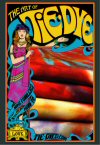
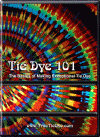
Tie-dye 101 is an excellent introduction to tie-dyeing for beginners, including a great deal of basic advice on exactly how to manage all of the details. This is an ideal instructional video to get if you are just starting out, or even if you have some experience. Available through True Tie Dye and Amazon.
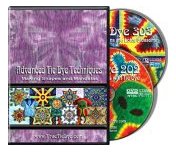 The secrets of tie-dyeing hearts, arrows, peace signs, aliens, mandalas, suns, lotus blossoms, and more. I was actually chagrined to realize how much this video had to teach me, after many years as, I thought, an expert tie-dyer. Like Michael Fowler's DVD, below, this two-DVD set is a must-have for any serious dyer. Dyers who have not previously explored tie-dye will be amazed at some of the possible effects, while experienced tie-dyers will find ideas that enrich and expand their repertoires. Available from True Tie Dye and Amazon
The secrets of tie-dyeing hearts, arrows, peace signs, aliens, mandalas, suns, lotus blossoms, and more. I was actually chagrined to realize how much this video had to teach me, after many years as, I thought, an expert tie-dyer. Like Michael Fowler's DVD, below, this two-DVD set is a must-have for any serious dyer. Dyers who have not previously explored tie-dye will be amazed at some of the possible effects, while experienced tie-dyers will find ideas that enrich and expand their repertoires. Available from True Tie Dye and Amazon
Mike Fowler: The Art of Tie Dye (DVD)

(January 2005) The Art of Tie Dye was the first professionally-produced video that provided answers for all of the people who wrote wanting MORE about exactly how to tie-dye. The video footage of famed tie-dyer Mike Fowler in action, actually tying a number of different designs for both Procion MX-dyed t-shirts and pigment-dyed tapestries, gave folding instruction that no web site or even book can duplicate. Very slick and professional video. Now out of print and very difficult to find.
Richard W. Rogers: How to Tie-dye Stars: Book 2 of the Tie-Dye Art Series
NEW REVIEW (11/2011)
 (2010) Previous books have never revealed the secrets of dyeing stars, among the most-wanted but also most challenging of designs. Not only does this book fill in the gap with clear easy-to-follow illustrations, it also includes many useful tips on tie-dyeing efficiently, plus advice on what to do about unwanted spots of dye, and how to produce a smooth background color without messing up the fine details of the star design. There are other books on how to mix dyes for tie-dyeing, but no other book covers the material in this one. This will be popular with tie-dyers who are ready to go beyond the basics. Note: although this is "Book 2 of the Tie-Dye Art Series", there is (as of 2012) no "Book 1" in the series yet; don't wait to buy them in order.
Available from Amazon. .
(2010) Previous books have never revealed the secrets of dyeing stars, among the most-wanted but also most challenging of designs. Not only does this book fill in the gap with clear easy-to-follow illustrations, it also includes many useful tips on tie-dyeing efficiently, plus advice on what to do about unwanted spots of dye, and how to produce a smooth background color without messing up the fine details of the star design. There are other books on how to mix dyes for tie-dyeing, but no other book covers the material in this one. This will be popular with tie-dyers who are ready to go beyond the basics. Note: although this is "Book 2 of the Tie-Dye Art Series", there is (as of 2012) no "Book 1" in the series yet; don't wait to buy them in order.
Available from Amazon. .
◊◊◊◊◊◊
Rita J. Adrosko: Natural Dyes and Home Dyeing (Formerly Titled: Natural Dyes in the United States). 1971. $8.95

This book was first published as United States National Museum Bulletin 281, under the title Natural Dyes in the United States.The first part of the book is a history of dye usage in America in the 18th and 19th century, of interest to students of textile and dyeing history. The second part contains practical recipes first published in 1935 and later tested by Abrosto. A major strength of this book is its descriptions of how washfast and lightfast each dye is on both wool and cotton; many natural dyeing books almost entirely neglect the question of whether a dye will work well on cotton. Recipes are included for flowers including aster, dahlias, marigolds, sunflowers, zinnias, chamomile; nut galls, butternut walnut or pecan hulls; sassafras root back on wool and on cotton; two kinds of indigo vats, metals including prussian blue, chrome yellow and iron buff; various leaves; hollygrape root; various tree barks, tea and coffee beans (not fast on cotton), two recipes for lichens; and commercial natural dyestuffs such as logwood, cutch, and madder. Excellent bibliography. 154 pages. Not particularly recommended for the beginner.
Anne Bliss: A Handbook of Dyes from Natural Materials. Charles Scribner's Sons, New York. 1981. $9.95.
In order to counter the popular belief that all natural dyes will lose their color quickly, Bliss used a weatherometer to test each of the dyes described for lightfastness. Unfortunately, she did not include similar information regarding washfastness. In order to accurately describe the colors, she used color codes from the Inter-Society Color Council—National Bureau of Standards (ISCC-NBS). She obtained recipes from dyers using a variety of natural dyes throughout North America. Detailed recipes for mordanting both plant and animal fibers are included. The recipes are listed according to the name of the dyer contributing them. This book contains a lot of valuable information, but it is not written to be useful for beginners. There are only a few illustrations, most in black and white. Good index.
Claire Benn and Leslie Morgan: Tray Dyeing: Exploring Colour, Texture and Special Effects
(2007) NEW REVIEW (1/2012)

This slim 44-page book, bound with two staples, is a good introduction to a popular form of dyeing. There's nothing new about the idea the authors are calling "tray dyeing", which is a slight variant of low water immersion dyeing in which Procion MX type dyes are poured on different parts of crumpled fabric that's been pre-soaked in soda ash. However, this is a good method, and it could be helpful for a beginner to have a book about it. The biggest weakness is a heavy reliance on the dyes and dye mixtures sold by a single dye supplier in the UK, KemTex Educational Supplies; there is no listing of equivalent dye selections from other suppliers, nor any attempt to distinguish widely-availables from proprietary color mixtures. No mention of similarly-colored dyes whose performance on soda-ash-soaked fabric is different. The instructions are reliable and the illustrations beautiful. Useful information on color mixing in general is included, and there are some nice pairings of nature photographs with similar effects achieved by dyeing fabric. Available through Dharma Trading Company and Amazon
.
Holly Brackmann: The Surface Designer's Handbook: Dyeing, Printing, Painting, and Creating Resists on Fabric (September 2006)
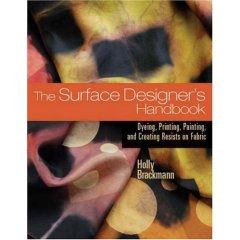
Holly Brackmann's book, The Surface Designer's Handbook: Dyeing, Printing, Painting, and Creating Resists on Fabric, is an all-purpose guide to dueing many fibers. 'Handbook' is a good description of it; it looks very useful in many different areas of dyeing and surface design. It contains chapters with detailed recipes for Procion MX and Cibacron F dyes, acid dyes and Lanaset dyes, vat dyes (including Inkodyes), disperse dyes for polyester, dye discharging, screen printing, monoprinting, stamping, stenciling, resists, itajime (clamping), pole-wrapped arashi shibori and stitch-resist nui shibori, dévoré, textile paints, and embellishments such as foiling. A technique I've never heard of is Brackman's own combination of dévoré (burn-out) with disperse dyeing in one step. The spiral binding allows the book to lie flat, important when using recipes. Beautiful professional photographs of dyed fabrics and art pieces are spread throughout the book. I especially enjoyed an example in which silk had been dyed black with acid dye and then simultaneously discharged and dyed with vat dyes.
Karren K. Brito: Shibori: Creating Color and Texture on Silk
 (2003) This may be the best introduction to the Japanese tie-dye art of shibori, though it is also suitable for experienced dyers. An excellent resource for information about dyes for silk, wool, and other animal fibers, in particular for Lanaset dyes (which include both fiber reactive dyes suitable for protein fibers and premetallized acid tdyes that work well with them), and the group of acid dyes known as Washfast Acid Dyes, which Britto refers to by the brand name of Nyloamine. Available from ProChem and Amazon.
(2003) This may be the best introduction to the Japanese tie-dye art of shibori, though it is also suitable for experienced dyers. An excellent resource for information about dyes for silk, wool, and other animal fibers, in particular for Lanaset dyes (which include both fiber reactive dyes suitable for protein fibers and premetallized acid tdyes that work well with them), and the group of acid dyes known as Washfast Acid Dyes, which Britto refers to by the brand name of Nyloamine. Available from ProChem and Amazon.
Kate Broughton: Textile Dyeing - The Step By Step Guide and Showcase.
 (1996) Not an appropriate book for the beginner. However, many beautiful examples, such as novel tie-resist methods
by Carter Smith, complete with well-illustrated instructions, and photos
of 3-D shibori sculptures, more than justify going to some effort to see this book.
Acid dyes and fiber reactive dyes. No index. [Out of print; may be available at Amazon.]
(1996) Not an appropriate book for the beginner. However, many beautiful examples, such as novel tie-resist methods
by Carter Smith, complete with well-illustrated instructions, and photos
of 3-D shibori sculptures, more than justify going to some effort to see this book.
Acid dyes and fiber reactive dyes. No index. [Out of print; may be available at Amazon.]
Melanie Brummer: Contemporary Dyecraft: Over 50 Tie-dye Projects for Scarves, Dresses, T-shirts and More.
 (2010) Clear, well-photographed instructions for tie-dyeing in buckets, with colors that range from brilliant to elegant and subtle. Techniques include solid color dyeing, a light-to-dark color gradation, crazed patterns, circles, spirals, stripes, geometric shapes, stitched hearts, and the South African flag. Unlike those in other books, these projects are designed for use with fiber reactive dyes which require hot water, such as Drimarene K dyes. (They will also work with room-temperature water using Procion MX fiber reactive dyes, and most could even be used with all-purpose dyes, if necessary.) Available from Amazon. Also available in Afrikaans as Eietydse Kleurkuns.
(2010) Clear, well-photographed instructions for tie-dyeing in buckets, with colors that range from brilliant to elegant and subtle. Techniques include solid color dyeing, a light-to-dark color gradation, crazed patterns, circles, spirals, stripes, geometric shapes, stitched hearts, and the South African flag. Unlike those in other books, these projects are designed for use with fiber reactive dyes which require hot water, such as Drimarene K dyes. (They will also work with room-temperature water using Procion MX fiber reactive dyes, and most could even be used with all-purpose dyes, if necessary.) Available from Amazon. Also available in Afrikaans as Eietydse Kleurkuns.
John and Margaret Cannon: Dye Plants and Dyeing
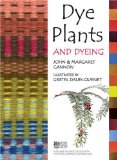
(2004) The pretty hand-drawn illustrations of each dye plant in this book are more useful than the photographs in many books. One full page is devoted to each dye plant, including information on where the plant originated, different varieties available, the chemical names of the dyes' active ingredients, and how to use the plant, with the full-page illustration on the facing page. This book is an excellent source for experienced dyers who want to know more about dyeplants and for students who want to know about the chemistry of specific natural dyes. It's the best source I've seen for information about a number of natural dyes, such as pokeberry, or the differences between old and young fustic, or the historical uses of Persian berries, among others. It does not include detailed step-by-step recipes suitable for beginners. Good index, botanical glossary, and list of further reading. Worth keeping on hand.
 (2002)
This is a beautiful book, more poetic than most of those reviewed here, full of gorgeous ideas on using nature for printing materials and inspiration. The fabric artist will wish to begin with Dahl's wonderful Transforming Fabric (see below), and then get this one for further inspiration; the paper artist will prefer to begin with Natural Impressions.
Available from the author as well as
Dharma Trading, ProChem, and Amazon.
(2002)
This is a beautiful book, more poetic than most of those reviewed here, full of gorgeous ideas on using nature for printing materials and inspiration. The fabric artist will wish to begin with Dahl's wonderful Transforming Fabric (see below), and then get this one for further inspiration; the paper artist will prefer to begin with Natural Impressions.
Available from the author as well as
Dharma Trading, ProChem, and Amazon.
Carolyn Dahl: Transforming Fabric - 30 Creative Ways to Paint, Dye and Pattern Cloth
 (2004) The subtitle for the 1997 edition of this book was Color on Fabric and Life.
The best explanations I've seen anywhere of all sorts of things: discussing
the differences between the types of rayon, say, giving complete instructions
for heat-transfer dyes of various sorts - including using them in stamp
pads! - complete instructions for using Inko dyes to make marvelous
sun prints (more distinct than with Setacolor fabric paint), destruction patterns,
rain patterns with airbrush ink (without an airbrush), excellent instructions
for printing with real leaves and with real fish. Procion MX and Procion H,
disperse dyes, textile paints. Good index. Dahl takes a more personal
approach than many authors in this field, with very readable and enjoyable results.
[Available from the author, ProChem and Amazon.]
(2004) The subtitle for the 1997 edition of this book was Color on Fabric and Life.
The best explanations I've seen anywhere of all sorts of things: discussing
the differences between the types of rayon, say, giving complete instructions
for heat-transfer dyes of various sorts - including using them in stamp
pads! - complete instructions for using Inko dyes to make marvelous
sun prints (more distinct than with Setacolor fabric paint), destruction patterns,
rain patterns with airbrush ink (without an airbrush), excellent instructions
for printing with real leaves and with real fish. Procion MX and Procion H,
disperse dyes, textile paints. Good index. Dahl takes a more personal
approach than many authors in this field, with very readable and enjoyable results.
[Available from the author, ProChem and Amazon.]
Jenny Dean: Wild Color: The Complete Guide to Making and Using Natural Dyes
(1999)
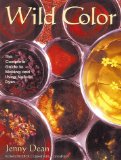
This is a lovely book for the wool dyer, but of limited usefulness to dyers of other fibers. For each plant, beautifully clear photos of the plant itself are shown, as well as color chips indicating what color will be produced on wool, with and without alum or iron. Very little notice is taken of the fact that many dyestuffs perform quite differently on cellulose fibers than on wool, although a couple of pages at the beginning of the book do explain how to mordant vegetable fibers. A nice touch is the page explaining how to make copper and iron mordants from copper or iron metal. Highly recommended for the beginning dyer who is interested in using natural dyes only on wool. Good index and bibliography. 144 pages.
 (1993) The name turned me away at first, as I am not dyeing for the theater. That
was a mistake. While I don't need the chapters on how to set up a dye shop for a theatre,
other information provided in this book is hard to come by elsewhere. Fiber reactive dyes,
acid dyes, 1:2 metal complex dyes, direct dyes, basic dyes for acrylics, disperse dyes,
metallics, textile paints, screen printing, 4 different discharge dyeing pastes, batik,
blue printing and brown printing on fabric (or whole garments), marbling, airbrush.
Much more thorough treatment of potential hazards than any other dyeing book I've seen.
Lists of carcinogenic dyes to avoid.
Actual test results of fabric feel and fastness of many different textile paints, each
on six different fibers. Good index. [Available at Amazon.]
(1993) The name turned me away at first, as I am not dyeing for the theater. That
was a mistake. While I don't need the chapters on how to set up a dye shop for a theatre,
other information provided in this book is hard to come by elsewhere. Fiber reactive dyes,
acid dyes, 1:2 metal complex dyes, direct dyes, basic dyes for acrylics, disperse dyes,
metallics, textile paints, screen printing, 4 different discharge dyeing pastes, batik,
blue printing and brown printing on fabric (or whole garments), marbling, airbrush.
Much more thorough treatment of potential hazards than any other dyeing book I've seen.
Lists of carcinogenic dyes to avoid.
Actual test results of fabric feel and fastness of many different textile paints, each
on six different fibers. Good index. [Available at Amazon.]
Jane Dunnewold: Complex Cloth - A Comprehensive Guide to Surface
Design
 (1996) This book has clear and complete instructions for nearly every
technique - dyeing, stamping, stenciling, silk screening, bleach
discharge, etc. It's a good source of instructions for bleach discharge,
and it has some of the most beautiful examples of combinations of
several techniques, for inspiration. This
book can easily be used by a beginner, but it has an immense amount to
offer to a more advanced fabric artist.
Available at Amazon
and Dharma.
(1996) This book has clear and complete instructions for nearly every
technique - dyeing, stamping, stenciling, silk screening, bleach
discharge, etc. It's a good source of instructions for bleach discharge,
and it has some of the most beautiful examples of combinations of
several techniques, for inspiration. This
book can easily be used by a beginner, but it has an immense amount to
offer to a more advanced fabric artist.
Available at Amazon
and Dharma.
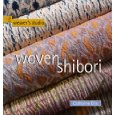 (2006.) This is a wonderful book. The author weaves pattern threads into her fabric that are pulled tight, after the fabric is removed from the loom, to create a descendant of mokume woodgrain shibori. Different sorts of dyes and discharges are used, including vat dyes, fiber reactive dyes, and acid dyes; the recipes are reliable and show a thorough understanding of how dyes work. More unusual techniques include the use of a felt resist paste, so that only the unresisted parts of the fabric become felted. There is even a brief description and photo of a piece of woven shibori made with stainless steel yarn and then affected by the heat of a torch. As a non-weaver myself, I cannot comment on how easy-to-follow the instructions for weaving may be, but the beauty of the many examples and the clarity of the text make me want to recommend that every weaver who is interested in dyeing read this book.
Available at Amazon
(2006.) This is a wonderful book. The author weaves pattern threads into her fabric that are pulled tight, after the fabric is removed from the loom, to create a descendant of mokume woodgrain shibori. Different sorts of dyes and discharges are used, including vat dyes, fiber reactive dyes, and acid dyes; the recipes are reliable and show a thorough understanding of how dyes work. More unusual techniques include the use of a felt resist paste, so that only the unresisted parts of the fabric become felted. There is even a brief description and photo of a piece of woven shibori made with stainless steel yarn and then affected by the heat of a torch. As a non-weaver myself, I cannot comment on how easy-to-follow the instructions for weaving may be, but the beauty of the many examples and the clarity of the text make me want to recommend that every weaver who is interested in dyeing read this book.
Available at Amazon.
Elaine Eskesen: Dyeing to Knit. 2005.

Dyeing to Knit is an excellent book for the beginning- to intermediate-level dyer who wants to learn how to dye wool yarns with acid dyes. The recipes are based on ProChem's WashFast Acid Dyes. Eskesen covers how to safely use dye powders, how to mix and combine colors, how to apply the dyes, and how to heat-set the dye. This book will not be very helpful to the knitter who wants to learn to dye acrylic yarn or yarns made with cellulose fibers such as cotton, linen, rayon, or hemp. There is some discussion of how to adapt the methods in the book for several other protein-based yarns, including silk, mohair, alpaca, llama, angora, and cashmere. Instructions are included for solid colors, space-dyed yarn, and hand-painted yarn. A number of knitting patterns round out the book with suggestions for using your own hand-dyed wool yarn.
Jill Goodwin: A Dyer's Manual. 2003 second edition. Ashmans Publications, East Yorkshire, England.
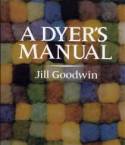 (2003) Very detailed and valuable resource for hand dyeing with natural materials, such as woad, lichens, and
assorted weeds. Avoid the first edition, published in 1982, which was inadequate in its treatment of the hazards of the mordants described: be sure to get the much improved second edition! Available internationally for 18 pounds, postage paid, from Goodwin's website.
(2003) Very detailed and valuable resource for hand dyeing with natural materials, such as woad, lichens, and
assorted weeds. Avoid the first edition, published in 1982, which was inadequate in its treatment of the hazards of the mordants described: be sure to get the much improved second edition! Available internationally for 18 pounds, postage paid, from Goodwin's website.
Sulfiati Harris: Rainbow Tie Dye. $5.
 (1990) Slim though it is, this is a great book for explaining the techniques of tying or
using thread to resist the dyes. It's also very inexpensive, at
$5. Highly recommended for the tie dyeing beginner. No longer available, but a new version, "Tie-Dye", is now sold by Dharma with Dharma's own recipes included.
(1990) Slim though it is, this is a great book for explaining the techniques of tying or
using thread to resist the dyes. It's also very inexpensive, at
$5. Highly recommended for the tie dyeing beginner. No longer available, but a new version, "Tie-Dye", is now sold by Dharma with Dharma's own recipes included.
(1993) Clever idea: put the dye in a spray bottle and place items, or folds, to create "shadows" where the dye doesn't go. The effects can be great. One of my favorite shirts I used real leaves and sprayed black and green dye on. A friend still talks about the bamboo pattern shown in the book, she was so impressed by it. Very slim, instructions for a good number of projects.[Out of print; formerly available from Dharma.]
Renate Henge: Inspirational Silk Painting from Nature.
(2001)

This slim volume does a wonderful job of showing how to use the scenes you see in nature to make beautiful silk paintings. Methods apply to both silk paint and silk dye; specifics of using different dyes and paints are not given, but specific techniques to use with them are explained well. Color mixing, salt effects, alcohol effects, wax, and gutta are each get about a page of explanation, briefly but with useful tips; then many examples are shown, with instructions for ways to use the techniques to depict specific effects as seen in nature.
Ruth Issett: Colour on Cloth: Create Stunning Effects with Dye on Fabric

Fabric Dyer's Dictionary: 900+ Colors, Specialty Techiniques, The Only Dyeing Book You'll Ever Need!
 (2010) Is this book truly "The Only Dyeing Book You'll Ever Need"? Certainly not for dyers using anything but Procion MX dyes on cotton. Even for Procion MX dyers, it's not—it omits some dye colors I consider basics, and uses too many premixed colors as mixing primaries—but it's nice to see hundreds of dye swatches from various color gradations, and the recipes are good. Too bad the swatches were all dyed from teaspoon measurements, instead of by weight so the colors could be better reproduced. Unfortunately, there's still no substitute for doing your own color mixing tests.
There are brief but sufficient recipes for what the author refers to as specialty dyeing techniques, including ombre (in this book referring not to large color gradations, but instead to pouring different colors of dye in lines or spots onto presoaked fabric, and smearing with gloved hands); twist, which is a simple version of the spiral tie-dye; layering (like Ann Johnston's parfaits); sprinkling dry dye powder onto presoaked fabric; rolling on a rope (known elsewhere as the ruching technique); painting with thickened dyes, and a pleat and dip technique.
I recommend this book for quilters who would like to see the results of mixing colors in many different combinations. For most dyers, this will not be the only dyeing book you'll ever need, but it's a good start, and may be useful.
Available from ProChem, Dharma Trading and Amazon. NEW REVIEW (2/2012)
(2010) Is this book truly "The Only Dyeing Book You'll Ever Need"? Certainly not for dyers using anything but Procion MX dyes on cotton. Even for Procion MX dyers, it's not—it omits some dye colors I consider basics, and uses too many premixed colors as mixing primaries—but it's nice to see hundreds of dye swatches from various color gradations, and the recipes are good. Too bad the swatches were all dyed from teaspoon measurements, instead of by weight so the colors could be better reproduced. Unfortunately, there's still no substitute for doing your own color mixing tests.
There are brief but sufficient recipes for what the author refers to as specialty dyeing techniques, including ombre (in this book referring not to large color gradations, but instead to pouring different colors of dye in lines or spots onto presoaked fabric, and smearing with gloved hands); twist, which is a simple version of the spiral tie-dye; layering (like Ann Johnston's parfaits); sprinkling dry dye powder onto presoaked fabric; rolling on a rope (known elsewhere as the ruching technique); painting with thickened dyes, and a pleat and dip technique.
I recommend this book for quilters who would like to see the results of mixing colors in many different combinations. For most dyers, this will not be the only dyeing book you'll ever need, but it's a good start, and may be useful.
Available from ProChem, Dharma Trading and Amazon. NEW REVIEW (2/2012)
 (2001) A guide to painting and printing with MX type fiber reactive dyes. Spiral binding lies flat during use. Ann's books are always very well worth buying. Unlike some dye authors, her grasp of chemistry means that the explanations are always correct, and make sense, so that you truly learn to understand your materials, instead of merely following incomprehensible recipes.
Available from the author as well as ProChem , Dharma Trading and Amazon.
(2001) A guide to painting and printing with MX type fiber reactive dyes. Spiral binding lies flat during use. Ann's books are always very well worth buying. Unlike some dye authors, her grasp of chemistry means that the explanations are always correct, and make sense, so that you truly learn to understand your materials, instead of merely following incomprehensible recipes.
Available from the author as well as ProChem , Dharma Trading and Amazon.
 (1992) An excellent book, absolutely. Detailed instructions and wonderful,
inspiring examples. More oriented to the artist than to the beginner. There is
no question but that Ann Johnston understands her recipes absolutely,
and she explains why she recommends each detail,
which makes adapting them to suit your wishes easy and safe.
Out of print; worth seeking out a used copy, for example at Amazon. Or see the author's more recent Color By Design.
(1992) An excellent book, absolutely. Detailed instructions and wonderful,
inspiring examples. More oriented to the artist than to the beginner. There is
no question but that Ann Johnston understands her recipes absolutely,
and she explains why she recommends each detail,
which makes adapting them to suit your wishes easy and safe.
Out of print; worth seeking out a used copy, for example at Amazon. Or see the author's more recent Color By Design.
Ann Johnston: Color by Accident.
 (1997) This was my favorite book in all of 1998. It focuses solely on "low water immersion dyeing", a
hybrid between direct application of dye to fabric that's been
pre-soaked in sodium carbonate, and dyeing in a bucket or washer, using
Procion MX fiber reactive dyes. The
results are gorgeous random blends of the colors you choose.
This is the technique that allows for true gradations of
color. Direct dye application, such as in regular tie-dyeing, causes
the dyes to react so quickly with the fabric that perfectly smooth
gradations of color are extremely difficult to achieve. You have to
see the pictures of its results to know how great this technique can be,
though. They are gorgeous. Unique to Ann's methods is the creation of 'color parfaits', tremendously useful in creating fabrics of several related colors for use in quilting. Available at Amazon
and Dharma.
(1997) This was my favorite book in all of 1998. It focuses solely on "low water immersion dyeing", a
hybrid between direct application of dye to fabric that's been
pre-soaked in sodium carbonate, and dyeing in a bucket or washer, using
Procion MX fiber reactive dyes. The
results are gorgeous random blends of the colors you choose.
This is the technique that allows for true gradations of
color. Direct dye application, such as in regular tie-dyeing, causes
the dyes to react so quickly with the fabric that perfectly smooth
gradations of color are extremely difficult to achieve. You have to
see the pictures of its results to know how great this technique can be,
though. They are gorgeous. Unique to Ann's methods is the creation of 'color parfaits', tremendously useful in creating fabrics of several related colors for use in quilting. Available at Amazon
and Dharma.
Linda S. Kanzinger: The Complete Book of Fabric Painting.
 (1986; revised 1993) This was once a surprisingly complete book, though rather dated, mentioning a huge
variety of commercial products by name. This is the closest thing to
an encyclopedia I think I've seen on this subject. The pictures are
mostly small and black and white. Useful, though the instructions
could be more detailed. Unfortunately many new fabric painting products are not included, due to having been introduced since this book's publication.
Out of print; may be available at Amazon.
(1986; revised 1993) This was once a surprisingly complete book, though rather dated, mentioning a huge
variety of commercial products by name. This is the closest thing to
an encyclopedia I think I've seen on this subject. The pictures are
mostly small and black and white. Useful, though the instructions
could be more detailed. Unfortunately many new fabric painting products are not included, due to having been introduced since this book's publication.
Out of print; may be available at Amazon.
Linda Knutson: Synthetic Dyes for Natural Fibers
(1986) Look for this out-of-print book at the public library; though it's long out-of-print, it's still an essential resource. Knutson is a chemist turned home dyer, and thus knows a lot more about the dyes than most authors. Although she never treats direct dye application, just immersion dyeing, her information on the chemistry of different types of dyes is extremely valuable. Discusses Fiber Reactive Dyes, Acid Dyes, Basic Dyes, and Lanaset Dyes. This is a must-have for the serious dyer, but is comprehensible by the beginner, too. The instructions in this book on how to use the metric system are essential for any dyer who is not already doing so. (You can usually find a used copy online through sellers such as Amazon.)
Jean Ray Laury: Imagery on fabric: a complete surface design handbook
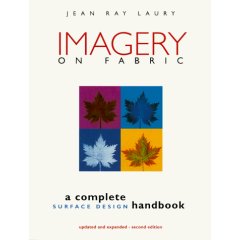
(1997) An extremely thorough guide to many different forms of image transfer, including solvent transfer of copier images, laser and inkjet printing of fabric and transfers, disperse dye transfer, crayon transfer, screen printing, cyanotype, stamping, discharge (bleach) printing, and Polaroid transfers. Clear troubleshooting sections. Caveats: not much discussion of just how washable the results of various techniques are (some should be washed no more than a few times, if that); mentions using vinegar to neutralize bleach, though it's a bad idea. Otherwise an excellent and very understandable resource. Essential if the transfer of images to fabric is among your interests.
Vimala McClure: Fabric Dyeing for Beginners
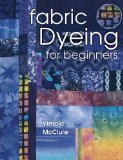
(2003) Just as the name implies, this book is a good introduction for beginning dyers. It covers what McClure calls "pickle jar dyeing", which is low water immersion dyeing with the variation of using soda ash first (instead of adding it to the fabric after the dye). McClure also covers tie-dyeing and fold-dyeing, though more cursorily. In all cases the emphasis is on dyeing fabric for use in quilting. The only obvious error is her claim that Procion MX dyes are "highly toxic"; they're not very toxic, but the good habits McCure teaches for avoiding unnecessary personal exposure to the dye should be followed closely in order to prevent serious allergies. This book would be a good choice for including with dyes as a gift for a quilter who wants to learn to dye, or for purchase by anyone who wants to learn how to use Procion MX dyes for the first time.
Jenni Milne: Silk Painting (The Art of Crafts)

(1999) The instructions in this book, oriented toward beginners, mainly call for the use of iron-set silk paints, rather than steam-set dyes, though a few of the recipes mention that steam-set dyes can also be used, and instructions for how to steam fabric are also included. There are specific instructions for a number of projects, including in many cases simple drawings to use for the painted motifs. There are individual chapters on using gutta, water, salt, anti-spread treatments, and batik wax. Instructions are also given for a project using sun-printing. The 'mistakes' section in a Design Tips chapter near the end will be useful to those beginning to use gutta.
Ann Milner: Ashford Book of Dyeing

(1998)
This is an excellent guidebook for all levels, from beginners to advanced dyers, using all sorts of dye, including natural dyes and synthetic dyes from many dye classes, including fiber reactive dyes, acid dyes, premetalized dyes, basic dyes, vat dyes, naphthol dyes, disperse dyes, and all-purpose dyes. The Ashford dye company, in New Zealand, manufactures a well-known line of acid dyes for wool, but they are treated in no more detail than the other categories of dye. Actual brands of dyes in different categories are named, making this a useful bridge between hand dyeing and the products used in the textile industry. 192 pages, well illustrated, compact and dense with information.
Joyce Mori and Cynthia Myerberg: Dyeing to Quilt
 (1997) Whether you quilt or not (I don't), any hand dyer can benefit from
this book's excellent treatment of the various pure Procion MX dyes. (I had to find this
same information by myself, the hard way.) Actual dyed swatches
make up the color wheels pictured to illustrate four different color palettes. You can
actually see the differences between the various blues or yellows, and compare to the result
obtained when using premixed colors for mixing primaries (much quieter and earthier).
Great discussion of mixing colors. Most other books limit you to just turquoise, fuchsia,
and yellow - which are fine, but it's a tremendous shame to skip the other pure MX dyes.
Quilts shown lean more toward traditional rather than modern art quilts. Available at Amazon.
(1997) Whether you quilt or not (I don't), any hand dyer can benefit from
this book's excellent treatment of the various pure Procion MX dyes. (I had to find this
same information by myself, the hard way.) Actual dyed swatches
make up the color wheels pictured to illustrate four different color palettes. You can
actually see the differences between the various blues or yellows, and compare to the result
obtained when using premixed colors for mixing primaries (much quieter and earthier).
Great discussion of mixing colors. Most other books limit you to just turquoise, fuchsia,
and yellow - which are fine, but it's a tremendous shame to skip the other pure MX dyes.
Quilts shown lean more toward traditional rather than modern art quilts. Available at Amazon.
Michelle Newman and Margaret Allyson: Handpainting Fabric: Easy, Elegant Techniques.
 (2003) A very good design book for a beginner who is using fabric paints. A major flaw is the inclusion of incomplete instructions for dye painting: the dye recipes should be attempted only by those who already fully understand how to use and fix dyes. However, most of the examples in the book are for fabric paints and are fine. Oddly, the author includes Dye-Na-Flow, a perfectly good fabric paint, in the dye section, instead of the section on fabric paints, which cannot be anything but confusing for the beginner. Available from Dharma and Amazon.
(2003) A very good design book for a beginner who is using fabric paints. A major flaw is the inclusion of incomplete instructions for dye painting: the dye recipes should be attempted only by those who already fully understand how to use and fix dyes. However, most of the examples in the book are for fabric paints and are fine. Oddly, the author includes Dye-Na-Flow, a perfectly good fabric paint, in the dye section, instead of the section on fabric paints, which cannot be anything but confusing for the beginner. Available from Dharma and Amazon.
Elin Noble. Dyes and Paints - A Hands-On Guide to Coloring Fabric.
 (1998, revised paperback edition 2003; this review is for the earlier edition.) Very much oriented toward quilt making. Many beautiful photos of
wonderful hand dyed art quilts, made by many different well-known fabric artists. Detailed
instructions, ideal for beginners, for use of MX fiber reactive dye and some textile paints,
including sunprinting with Setacolor paint. Good troubleshooting sections for dyeing and marbling.
Excessive reliance on ProChemical's brand names. No explanation of why, for example,
bicarbonate is added to carbonate in her dye printing recipes (it turns out that bicarb decomposes into carbonate during heat treatment). Small section on tie dyeing
has more unusual methods than most, with beautiful examples. Available from ProChem and Amazon.
(1998, revised paperback edition 2003; this review is for the earlier edition.) Very much oriented toward quilt making. Many beautiful photos of
wonderful hand dyed art quilts, made by many different well-known fabric artists. Detailed
instructions, ideal for beginners, for use of MX fiber reactive dye and some textile paints,
including sunprinting with Setacolor paint. Good troubleshooting sections for dyeing and marbling.
Excessive reliance on ProChemical's brand names. No explanation of why, for example,
bicarbonate is added to carbonate in her dye printing recipes (it turns out that bicarb decomposes into carbonate during heat treatment). Small section on tie dyeing
has more unusual methods than most, with beautiful examples. Available from ProChem and Amazon.
 Alice Niemiec et al.: Tie Dye to die for and batik you can't
resist. $5.95.
Alice Niemiec et al.: Tie Dye to die for and batik you can't
resist. $5.95.
Short book with good instructions for tying; specific instructions for a
number of projects using Procion MX dyes, with color photos of the final results. The recipes
work, but the authors don't always seem to understand why. 29 pages. Available at
Dharma.
Chris Rankin: Terrific T-Shirts: Hundreds of Ways to Create Your Own Great Designs

This book is a combination of two earlier Lark books, The Great T-Shirt Book: Make Your Own Spectacular, One-Of-A-Kind Designs, by Carol Taylor (1992), and The Ultimate T-Shirt Book: Creating Your Own Unique Designs, by Deborah Morgenthal (1998), copied word-for-word and photograph-for-photograph. It contains almost no new material at all. (See review below.)
Oddly, the copyright page gives no indication that the book consists of previously published material. Even the names of the two original authors, Carol Taylor and Deborah Morgenthal, do not appear anywhere on or in Chris Rankin's book, not even on the copyright page. Publishing old books under a new name, with a new author, amounts to fraud against buyers who previously purchased the earlier books. We are going to have to be very cautious about mail-ordering anything published by Lark Books.
Those who did not purchase the earlier books will find this book to be useful and inspiring. It contains a large number number of well-photographed, beautiful, professional-looking examples of how to paint, tie-dye, stamp, marble, batik, and screen print t-shirts. The instructions are not detailed enough to be of much use, nor are they completely reliable, but they are good enough to help you decide whether a technique sounds intriguing enough to bother finding more reliable instructions for it.
Lynne Richards & Ronald J. Tyrl: Dyes from American Native Plants: A Practical Guide
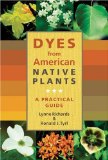
Richards and Tyrl tested recipes from the interviews found in the 1930s government document Indian Pioneer Papers, then categorized the results by color. Their book explains the history and the processes of natural dyeing, then devotes one chapter to each of the color groups yielded by the dyes. Chapter titles include "Purple and Red: Nature's Rarest Dye Colors", "Green: Nature's Own Color". "Yellow: Nature's Most Bountiful Color", "Orange: Nature's Brightest Color", "Brown: Nature's Autumn dye Color", "Black: Nature's Neutral Dye Color", and, importantly, "Materials That Produce Little Or No Color". They include pictures showing how to skein and tie yarn for dyeing. Good treatment of safety issues concerning mordants. Disappointingly, there are no blue dyes, and the purple and red dyes are dull in color and very limited in number. The second half of the book is a field guide to the plants used in the first half, complete with good photographs of the plants. Good glossary and index. 339 pages.
 Rosi Robinson: Start to Batik. $10.95 or £6.99
Rosi Robinson: Start to Batik. $10.95 or £6.99
(2009) Very good book for beginning batik. Explains use of Procion MX dyes with batik wax to decorate fabric and paper. Good illustrations and step-by-step instructions. Originally published in the UK; some puzzling phrases such as "extension lead" for "extension cord" remain in a glossary without explanation.
Richard W. Rogers: How to Tie-dye Stars: Book 2 of the Tie-Dye Art Series
NEW REVIEW (11/2011)
 (2010) Previous books have never revealed the secrets of dyeing stars, among the most-wanted but also most challenging of designs. Not only does this book fill in the gap with clear easy-to-follow illustrations, it also includes many useful tips on tie-dyeing efficiently, plus advice on what to do about unwanted spots of dye, and how to produce a smooth background color without messing up the fine details of the star design. There are other books on how to mix dyes for tie-dyeing, but no other book covers the material in this one. This will be popular with tie-dyers who are ready to go beyond the basics. Note: although this is "Book 2 of the Tie-Dye Art Series", there is (as of 2012) no "Book 1" in the series yet; don't wait to buy them in order.
Available from Amazon. .
(2010) Previous books have never revealed the secrets of dyeing stars, among the most-wanted but also most challenging of designs. Not only does this book fill in the gap with clear easy-to-follow illustrations, it also includes many useful tips on tie-dyeing efficiently, plus advice on what to do about unwanted spots of dye, and how to produce a smooth background color without messing up the fine details of the star design. There are other books on how to mix dyes for tie-dyeing, but no other book covers the material in this one. This will be popular with tie-dyers who are ready to go beyond the basics. Note: although this is "Book 2 of the Tie-Dye Art Series", there is (as of 2012) no "Book 1" in the series yet; don't wait to buy them in order.
Available from Amazon. .
Carol Taylor: The Great T-shirt Book (1992)
[Available at Amazon
and Dharma.]
and
Deborah Morgenthal: The Ultimate T-Shirt Book : Creating Your Own
Unique Designs (1998)
[Available at Amazon]

 These two books are very similar....the instructions in Morgenthal's book are very close paraphrases of those in Taylor's book....but they are not redundant, more like a volume I and
volume II in effect, since the projects are different. Each shows a
large number of different t-shirts that have been dyed and/or painted
and/or printed by various methods. *Great* source
of inspirations, plus some basic instructions which will not be
enough for the beginner, but at least lets you know whether a given
technique sounds like something you want to take up.
These two books are very similar....the instructions in Morgenthal's book are very close paraphrases of those in Taylor's book....but they are not redundant, more like a volume I and
volume II in effect, since the projects are different. Each shows a
large number of different t-shirts that have been dyed and/or painted
and/or printed by various methods. *Great* source
of inspirations, plus some basic instructions which will not be
enough for the beginner, but at least lets you know whether a given
technique sounds like something you want to take up.
Diane Tuckman and Jan Janas: The Best of Silk Painting

(1997)
This is a collection of works by many different silk artists, using a variety of styles, techniques, and materials. Brief descriptions of techniques are given. Materials used include Dupont silk dyes, Procion H dyes, Tinfix and Super Tinfix dyes, ProChem's Washfast Acid dyes, Jacquard Red Label Silk Colors, Lanaset dyes, indigo, Procion MX, and Visionart Instant Set (now Colorhue), as well as gutta, wax, and other resists. Beautiful pictures provide inspiration for you as a silk painter.
Katy J. Widger: Print Your Own Fabric. About $16.
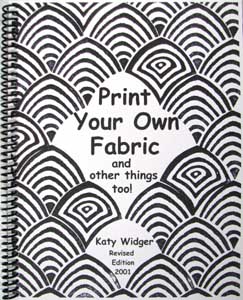 This looks self-published, in black and white. What it says is
simple, but extremely usable for printing fabric with both fabric paints and dyes. The enclosed brochure of fabric stamps sold
by Katy Widger is useful in its own right, as well, inspiring further
ideas. [Available only from the author's website.]
This looks self-published, in black and white. What it says is
simple, but extremely usable for printing fabric with both fabric paints and dyes. The enclosed brochure of fabric stamps sold
by Katy Widger is useful in its own right, as well, inspiring further
ideas. [Available only from the author's website.]
David G Duff and Roy S Sinclair: Giles's Laboratory Course in Dyeing, Fourth Edition (1989). ISBN 0 901956 49 X. Price: £12.00.

Every serious student of dyeing, every single student who writes to me about taking his or her A-levels about dyeing or who wants to know more about the use of dyes in the textile industry, should start with this book. Dye artists do not need to read it unless they have a great interest in technical information on dyeing. I found this book to be remarkably clear, since it is written for students, although the technical language will not appeal to the non-chemist. Giles's Laboratory Course in Dyeing can be ordered, new, from the Society of Dyers and Colourists in England, for the modest sum of £12, far less than the cost of a used copy in the US, even after adding in an additional 50% or so for overseas shipping. I highly recommend it.
John Shore (ed): Blends Dyeing. Price: £29
 (1998) Another technical book, suitable for scientists and engineers, covers many aspects of dyeing multi-fiber blends, including nylon/wool, wool/acrylic, wool/cellulosic, cellulosic/acrylic, cotton/viscose, polyester/wool, polyester/acrylic, polyester cellulosic, triacetate/polyester, and three-component blends. 236 pages, ISBN 0 901956 74 0
[Available online from the Society of Dyers and Colorists.]
(1998) Another technical book, suitable for scientists and engineers, covers many aspects of dyeing multi-fiber blends, including nylon/wool, wool/acrylic, wool/cellulosic, cellulosic/acrylic, cotton/viscose, polyester/wool, polyester/acrylic, polyester cellulosic, triacetate/polyester, and three-component blends. 236 pages, ISBN 0 901956 74 0
[Available online from the Society of Dyers and Colorists.]
John Shore (ed): Cellulosics Dyeing. Price: £9.00 £32
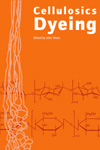 (1995) The best resource for those wishing to understand the
chemistry of the dyeing of cellulose fibers at a more
technical level. Chemical structures, reaction mechanisms,
electron micrographs of cotton fibers, etc. - this is the one book that all those students who e-mail me (wanting me to spoon-feed them everything they need to know for their A-levels) should consult, instead. Highly recommended for those with a scientific background or who have taken some chemistry courses. [Available online from the Society of Dyers and Colorists.] 418 pages, ISBN 0 901956 68 6.
(1995) The best resource for those wishing to understand the
chemistry of the dyeing of cellulose fibers at a more
technical level. Chemical structures, reaction mechanisms,
electron micrographs of cotton fibers, etc. - this is the one book that all those students who e-mail me (wanting me to spoon-feed them everything they need to know for their A-levels) should consult, instead. Highly recommended for those with a scientific background or who have taken some chemistry courses. [Available online from the Society of Dyers and Colorists.] 418 pages, ISBN 0 901956 68 6.
Victor B. Ivanov: Reactive Dyes in Biology. ISBN 3-7186-0235-0. Originally published 1982; English translation 1987. Harwood Academic Publishers, PO Box 786, Cooper Station, New York, NY 10276.

This book is written for the scientist; it's easy enough reading
for anyone who's done graduate work in biology or chemistry, but no
fun at all for those without the training. It's a wonderful source for
all sorts of odd bits of info on reactive dyes, including the Procion
series. It is extremely expensive - most would agree far too expensive for the
home library - but it is available at some research or medical school
libraries. Ask at your local library about Interlibrary Loan. This book is highly recommended for the scientist who needs to stain proteins or carbohydrates with reactive dyes. Table of Contents: 1. Structure, classification, and properties of reactive dyes; 2. Reacting Dyes with carbohydrates; 3. Reacting Dyes with Proteins; 4. Conventional versus reactive dyes in microscopy and hitochemistry; 5. Reactive dyes as histological stains; 6. Reactive dyes in histochemistry; 7. Staining living cells, tissues, and organisms with reactive dyes. [Available at great expense from Amazon; look for a used copy, or ask your local public library about Interlibrary Loan.]
The Colour Index.
The basic resource on all sorts of dyes, published jointly in the US and the UK. 6 volumes, very expensive (the volume we want, Part 2, costs £275.00 on CD), but available for in-library use only at some research libraries (check the universities in your area). Available from The Society of Dyers and Colourists.

History of dye chemistry; classifications, structures, and chemical synthesis of every type of synthetic dyes. Information on industrial application of dyes to fibers and in non-textile uses. The interesting discussions of what kinds of structures lead to different colors are nearly unreadable by non-scientists. Actual recipes are given for synthesis of many dyes for both natural and synthetic fibers. Available at Amazon; also available at some public libraries.
Advertisements
All of the pages on this site are copyright © 1998-2025 Paula E. Burch, Ph.D.
Last updated: February 16, 2012
Page created: August 14, 1999
Downloaded: Monday, December 08, 2025, 10:27AM EST